Podcast: Play in new window | Download (Duration: 28:39 — 33.8MB)
Subscribe: Apple Podcasts | Spotify | Amazon Music | Android | Pandora | iHeartRadio | JioSaavn | Podcast Index | Email | TuneIn | RSS | More
By Davy Crockett
![]()
![]()
Both a podcast episode and a full article
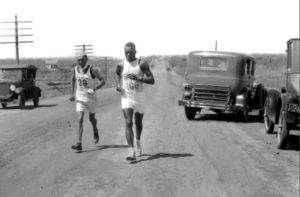 On May 10, 2019, America will celebrate the 150th anniversary of the completion of the transcontinental railroad in 1869, that was recognized with a “Golden Spike” ceremony at Promontory Point, Utah. For more than 150 years adventurers desired to travel across the American continent by various means: horse, wagon, train, automobile, and eventually on foot in one go. With this celebration coming up, it seemed appropriate to recognize some historic accomplishments walking or running across the American continent.
On May 10, 2019, America will celebrate the 150th anniversary of the completion of the transcontinental railroad in 1869, that was recognized with a “Golden Spike” ceremony at Promontory Point, Utah. For more than 150 years adventurers desired to travel across the American continent by various means: horse, wagon, train, automobile, and eventually on foot in one go. With this celebration coming up, it seemed appropriate to recognize some historic accomplishments walking or running across the American continent.
The most notable early walk across America was accomplished by the famous Pedestrian Edward Payson Weston in 1909. Weston accomplished the transcontinental walk at the age of 71. That was just six years after the first two men drove an automobile across America from San Francisco to New York in 63 days. By the time Weston began his famed walk, the fastest known time driving across the continent had been lowered to 15 days, 2 hours, 10 minutes. A train had accomplished it in 71 hours 27 minutes. Weston would capture the attention of the country and the world when he accomplished it on foot in 1909. That story will be covered in an upcoming article.
However, Weston first got the idea in 1869 when a best-seller book was being read about a young man, who years before had walked across South America. Weston very likely got the idea to walk across North America from the adventure that took place in 1855. Few have heard this story. It needs to have a place in ultrarunning history because it inspired the Pedestrian world and planted in the minds of many to do cross continent walks and runs in the future.
Not only would runners run across America (3,100+ miles), but they would go across Australia (2,890), New Zealand (1,350 miles), Europe (1,729 miles), Canada (4,179 miles), Asia (5534 miles), the Soviet Union (7,321 miles), the length of Great Britain (840 miles), Ireland (375 miles), and South America (8,500 miles).
But it seemed to all start with a young seventeen-year-old American adventurer in 1855. Here is his story.
Nathaniel Holmes Bishop (1837-1902)
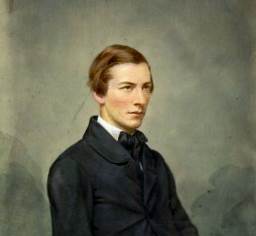

With only $45 in his pocket, he hired on as crew on a roach-infested merchant ship that was heading for Buenos Aires, Argentina. He endured weeks of seasickness but “became tolerably familiar with the duties of life at sea” growing strong and hearty. For three weeks the rainy season arrived, and he was “wet to the skin” as clothes, bedding, everything was “saturated from the effects of a leaky deck.” He arrived in South America during the “pampero” hurricane season and witnessed tragedy as other vessels were capsized and sailors drown.
Buenos Aires


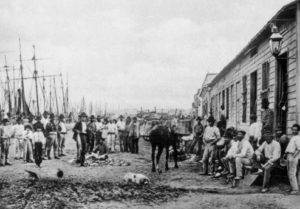

At Buenos Aires Bishop was still obliged to his mariner duties and remained on the ship for an entire month waiting for orders that he could be set free. Finally on February 20, 1855, he was discharged and was able to go ashore and went to the American consulate.
The Consul thought he was crazy to undertake a walk of about 1,000 miles across the continent alone especially because he was unable to speak Spanish. Bishop wrote, “However he furnished me with the necessary papers of protection, together with letters of introduction to various persons in the interior.”
Bishop would first have to face the vast “Pampas” which are vast plains including places without trees. He learned that the realistic way to cross the Pampas on foot, was to hitch up with a caravan of merchants, otherwise it would be impossible to obtain food, water and follow the right trail. This is because after March the Pampas sees very little rain and is filled with wildlife on its grasslands.
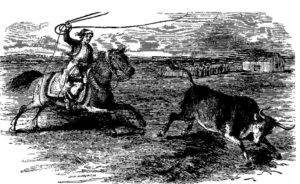

Bishop learned that a merchant caravan would be starting out during April from Rosario, located about 200 miles to the north and it would be traveling across the Pampas to Mendoza, a town at the base of the Andes. He wanted to join their company but had to wait two weeks for passage on a steamboat to take him to Rosario. While waiting, he met a young man who took him to his home in nearby Uruguay where he was able to observe the life of the gaucho (horsemen).
Bishop met an Irish gentleman who had crossed the Pampas recently, giving him a discouraging description. The Irishman described the Pampas, “the country is more uninteresting than any I ever traveled over, in any quarter of the globe. I should divide it into five regions; first, that of thistles, inhabited by owls and viscachas (rodents); second, that of grass, where you meet with deer, ostriches, and the screaming, horned plover (birds); third, the region of swamps and morasses, only fit for frogs; fourth, that of stones and ravines, where I expected every moment to be upset; and; last, that of ashes and thorny shrubs, the refuge of the tarantula and giant bugs.” Bishop was told that he should give up the idea and return to America.
Start in Rosario
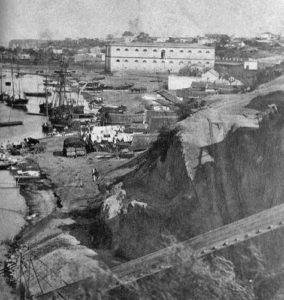

Bishop was undeterred, returned to Buenos Aires and took a 48-hour steamboat ride to Rosario, a city of about 8,000 people. He arrived there on March 30, 1855 and was paddled ashore from the steamboat in a log canoe. He still had to wait about a week before the caravan departed. He was able to join the company for $22, payment in advance that included food, hauling his things, and most important, protection.
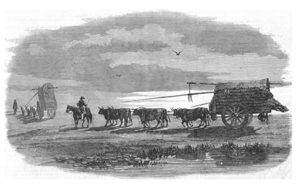

Bishop let the company know that he wanted to cross the Pampas on foot. They didn’t believe it could be done. The caravan consisted of 14 two-wheeled carts loaded with sugar, iron and other merchandise pulled by oxen. Also with them were about 20 spare oxen, a dozen mules and many horses. People in the company told him he should get in a cart that walking was “injurious to the system.”
The company included a cook who he relied on for his meals. He started his transcontinental walk in early April 1855 with the first goal to reach Mendoza. The distance for that segment in those days was said to be 800 miles and typically took the merchants 40 days to travel. But the distance was probably less than 700 miles. It can be driven today in about 550 miles. The Pampas are pretty flat but with some hills to climb over. The route climbs about 8,000 feet and descends about 5,000 feet along the way.
Walking across the Pampas
Day after day Bishop walked with the caravan, usually ahead of them, as they passed over the plains and through towns. They met others on the road going to or from Mendoza. One day a woman in Bishop’s caravan got a large splinter in her foot. He played the doctor role and successfully extracted it. He wrote, “As I was successful, she seemed overwhelmed with gratitude, and from that time she was almost the only friend that I had among the people of the troop.”
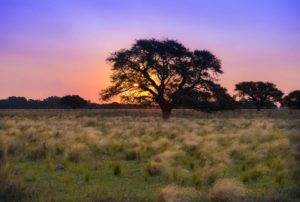

The Pampas have their own unique beauty. Bishop commented, “We continued our journey while the sun left in the western heavens beautiful clouds of purple and gray as souvenirs of his company through the bright, warm day.” At sunset, Bishop would see numerous owls leave their holes for the night in search of food. Night on the plains were cold. At times Bishop was tormented by mosquitoes and flies and had to roll a blanket around his head to sleep.
Mirages were fascinating to Bishop as he walked along, “The clearness of the atmosphere gave great effect to the mirages that we constantly beheld around us. Twice we seemed to see large lakes far in advance of our caravan, but they vanished utterly upon our moving nearer them. On our right, in the distance, the mirage so much resembled the ocean, that our carpenter exclaiming, ‘Jul mar!’ (the sea).”
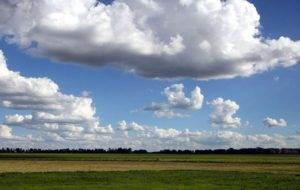



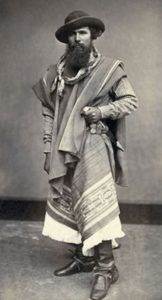

Bishop tried to fit in. During a rest, he turned his blanket into a poncho by cutting a hole in the middle, and thrusting his head through it. He said, “When the gauchos saw my new garment, they shouted in admiration; and one or two exclaimed, ‘Gaucho, Boston.'”


Rio Cuarto to Mendoza
Bishop’s journey wasn’t totally on flat plains. For several days, they needed to cross over high hills but his physical fitness had increased. He knew he was always surrounded by dangers from thieves, animals, and the elements, but gained confidence as he went along. He wrote, “everything was novel and captivating to the fancy. I was at last among a strange people, and their habits and mode of life, and the many incidents that were constantly occurring, were full of interest to me. Although my heart was light, I trudged along cheerfully and with courage.”
However, as they went along, he noticed that the gauchos started to be unfriendly toward him. He said, “their coolness grew more noticeable, and at length I began to fear that we should not part without a collision.” He had been warned by the son of the woman friend in the company that certain men might try to poison him. One morning when the leader of the caravan, Bishop’s protector, was a away, Bishop was apparently poisoned by some members of the caravan who didn’t like him. After breakfast he became violently ill, could not move, and passed out in a cart. Unfortunately he had to ride instead of walk for a few days. But once he recovered, he continued his “pedestrian journey.”
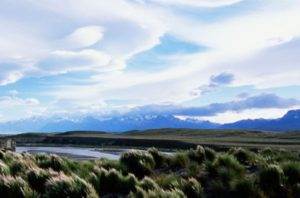

After many days and several hundred miles, Bishop was overjoyed with a sight seen ahead. “Far in the distance a dim, blue line, penciled upon the heavens, told me that I had obtained my first view of the Andes, that mighty range of mountains which traverses two continents and a dozen countries though known by different names. What emotions were aroused within me as I gazed at that faint streak that seemed floating in the air, for below it all was enveloped in clouds.”
At the town of Santa Rosa, with the Andes in full view, he started to ask around about the possibility of still going over the mountains into Chile this late in the season. He obtained some good information of about conditions and met for the first time on his walk others from North America. They were an “Olympic Circus” company that had been traveling and performing for years in the various countries of South America. The performers peppered him with questions about news from the United States.
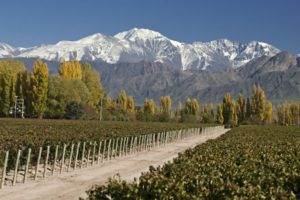

Pressing on toward Mendoza, when Bishop reached a crossing of Mendoza River, he decided to take a bath, only his third one since starting his journey. He wrote, the [gauchos] laughed derisively at a gringo who could not travel eight hundred miles without washing himself. These disgusting fellows, with one or two exceptions, had not applied water to their skin for more than forty days, and did not intend to cleanse themselves until the troop was close upon Mendoza.”
As they came closer to the mountains, their fall weather became colder. Bishop wrote, “The wind blew direct from the west, and coming from the snowy mountains, was very chilly. All night I turned and rolled upon my hide in great discomfort from the cold that benumbed my limbs.”
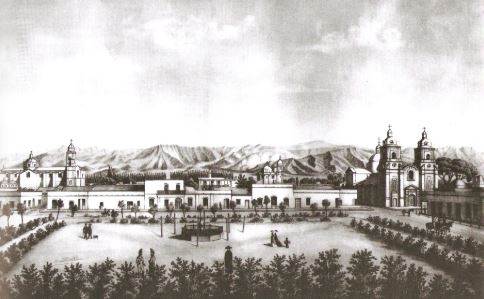

Bishop finally arrived at Mendoza, at the base of the Andes. He had covered about 700 miles in an estimated five weeks. However he was disappointed to learn that the last caravan to for Chile had left on the day after his arrival. But later he learned that the troop had barely succeeded in reaching Chile alive.
It was May and winter was arriving in the southern hemisphere. For the next 21 days the Andes were enveloped with clouds and storms. He realized, “to have attempted a passage at that time would have been certain death.” So, while he was disappointed, he became resigned that his walk would need to be halted until late spring when the snow drifts that blocked the passes had melted.
Winter Delay in San Juan
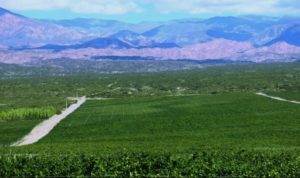

After spending a few weeks in Mendoza, some circus performers persuaded Bishop to join them traveling about 100 miles north to the city of San Juan, a city of about 9,000 people. Bishop agreed and traveled by mule train to that city. During the winter this city stays warm with temperatures into the 70s and is wine country. In the 1850s large fields of clover surrounded the city. Canals brought water from the San Juan River.
Bishop wrote, “As soon as I arrived at San Juan, I made inquiries for parties who were about crossing the mountains; but owing to a most severe snowstorm that set in, the clouds of which were plainly visible from the town, I was forced to the disagreeable necessity of remaining until the snows melted. The people told me that the winter had proved to by the most severe of any season within the last thirty years.”
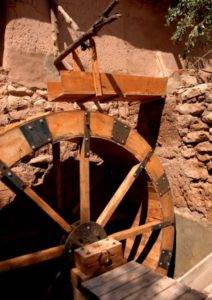

Word circulated that an American was in town and Bishop was invited to come to the estate of Don Guillermo who had been born in North America. Bishop took a job to oversee Don Guillermo’s grist mill which ground wheat to flour. He was given fifteen minutes of training and then put in charge of the entire operation. He became very contented in his work. It was a very busy time for mill the business. Traveling merchants would frequently sell their goods for wheat and then bring it to the mill.
Through the winter, Bishop still longed to get to the mountains. He wrote, “Leaving the dusty atmosphere of the mill, I frequently wandered out into the night air to gaze upon nature by moonlight. The Andes towered above the plains a few miles to the west, while on the east the solid range of the mountains of Cordova, stretching far to the north, gave an additional grandeur to the scene. While I strolled along the banks of the canal the mill hummed on as usual,”
Bishop experienced the very odd “Vicente de Vonda” or Vonda Winds that were local to San Juan. In the dead of the winter, these hot winds (thought to be volcanic) would blow from the Andes bringing huge clouds of dust. Everyone would leave their work and seek refuge in houses. Sickness including headaches would result and at times people dropped dead. They usually only lasted 3-4 hours.
As spring came, Bishop learned that the northern passes in the Andes were still buried in snow and that a party of eight who were attempting to cross into Chile were frozen to death. At another valley, eleven had fell victim to a fierce snowstorm. Bishop was planning on an early start of his trek but a man visited him who had just attempted the passage and said, “Suddenly a great temporal came flying from the south and enveloped us for many hours in its terrible folds. The snow fell in clouds and I, of all my party, escaped. My companions are frozen in the drifts, and there they will remain until the melting of the snow.” He showed him his frost-bitten fingers, cheeks, and nose. Bishop decided to postpone continuing his walk for another month.
Walking over the Andes
After a six month delay, on November 10, 1855, Bishop bid goodbye to his winter friends, returned to Mendoza and set off toward the Andes crossing terribly swollen rivers. He took a horse with him as a pack animal but did ride on it to cross the raging rivers. One night he stayed overnight in a small poverty-stricken village with huts and the women were alarmed that he was traveling alone on foot. At 18 years old, they thought he was too young and asked if his mother knew that he was out there.
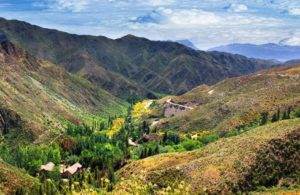

He ascended and crossed high plains. “Upon one side of the plain rose several low hills, green with coarse herbage, upon which a small herd of llamas were feeding, as if unconscious of the presence of man.”
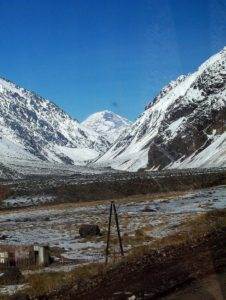

He arrived at Uspallata a town near the Chilean border at 6,690 feet and passed by the last house along the road in Argentina. He was informed be the house owner that the road conditions ahead were difficult and he was advised to stay a few days. But Bishop knew the dangers of delays so continued.
Soon a caravan driving mules arrived who knew his winter friends from San Juan. They had been on the lookout for Bishop and invited him to travel with them. He accepted. They put shoes on his pack horse to prepare for going over the Andes ahead.
The ruggedness of the Andes was spectacular. “In some places the path wound like a thread along the bold front of a precipice; then it descended to the water, and followed its course, until it again ascended. As we gazed above, the huge pieces of detached rock seemed ready to fall and crush us. The melting snow had undermined the soil in some places, and slides of earth and stones had fallen, and covered up the track.”


As Bishop walked along the mountainous road, he noticed piles of bones from animals that had died of hunger or fell off cliffs, lodged in the rocks. “It was truly, like going through the Valley of Death, so numerous were the carcasses and bones.” Giant condors were seen on the cliffs and circling high in the sky. He said that the difficult mountain walk at altitude “thoroughly jaded me, and I needed no narcotic to insure a sound sleep” at nights. His companions cautioned him against walking because of the danger of inhaling bad air which could make you sick. (At that time they didn’t understand the cause altitude sickness.)
They hit deep snow drifts near the summit of a stretch of a mountain range they called Paramilla. Footing was terrible, especially for the animals who sometime fell into concealed holes. Finally, the main range of the Andes rose above him, glistening in the sun. His caravan leader ordered everyone to drink a concoction of starch water and sugar that was believed to help against the effects of altitude. They then wrapped their faces with cotton handkerchiefs to protect from the sun rays. But Bishop had failed to bring goggles with him and soon was plagued with painful snow blindness.
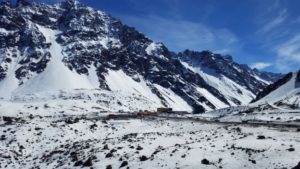

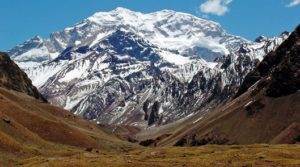

Bishop walked south of the massive peak, Aconcagua , the highest peak in South America that rose to 22,841 feet. They pushed on and soon entered into Chile, crossing over the Andes spine at about 12,500 feet. The snow thawed faster and the mules post-holed badly. At times they came to steep descents. Bishop said “we slid down the drifts in a most exhilarating manner. Getting the mules to also slide was a hard task, but eventually they would sit on the snow and “gracefully descend without injury.”
Chile
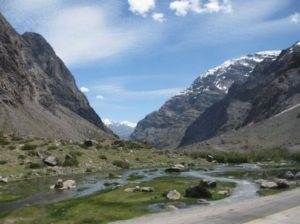

Bishop walked near the mighty Aconcagua River in Chile that roared along the mountain sides and in most places was still hidden under frozen snow. But soon their path became easier, Bishop wrote, “After following many windings, and experiencing much danger in crossing the river, the dry brown earth was reached, and we looked up to the lofty mountains, that shone in the moonlight, with great satisfaction, for our labors were ended.”
Civilization soon appeared and Bishop was impressed that the Chileans in the valleys were very energetic and intelligent. They wore short ponchos and had lassos hanging in coils on their saddles. As he went along, farms became more frequent and the buildings were roofed with red tiles shaded by groves of fruit trees.
Bishop bid adios to his faithful pack horse who was enjoying grazing in an alfalfa field. He wrote, “When I left him, he gave a pleasant whisk of his tail and shake of the ears, apparently thanking me for leaving him so literally ‘in clover.’”
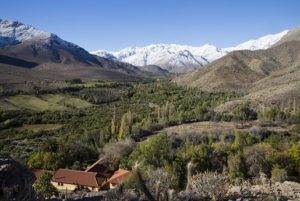

Bishop chose to end his pedestrian journey at Santa Rosa (now called Los Andes), a town about two days’ walk (40 miles) from the Pacific Ocean. The leader of the mule train insisted that he stay with him, as his son’s home. He wanted to introduce him to his countrymen and Bishop had a wonderful visit.
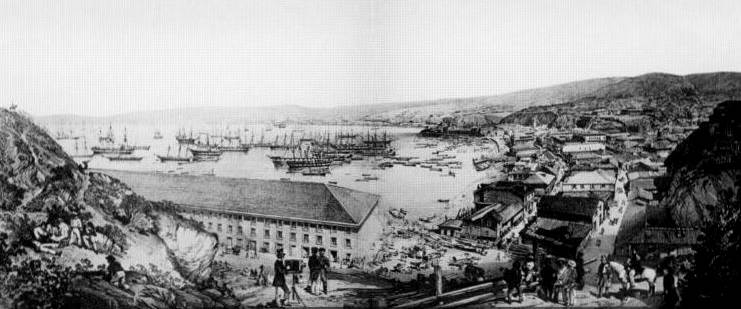

The next day he was taken to Valparaiso on the coast and he showed his papers to the US consul. He wrote that he was given a kind reception “and warm congratulations on the success of my long journey.” The consul arranged for Bishop a berth on an American vessel that would take him around Cape Horn and back to his home in Massachusetts.
Most accounts say that Bishop took two years to cross South America but that is not correct. While his personal account doesn’t specify exact dates often, it is very clear that he accomplished it all within 1855. His trek over the Andes of about 200 miles, only took about two weeks. He finished on about November 24, 1855. The elapsed time for his walk, including his long six month winter stop was about 7.5 months. His total traveling weeks were about seven weeks or about 50 days, covering about 900-1,000 miles, walking about 20 miles per day.
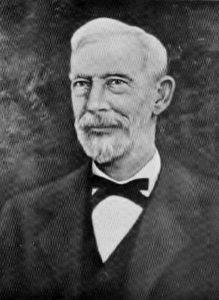

A newspaper in Valparaiso, Chile reported on November 27, 1885, “There arrived here, a few days since, a young man belonging to Medford, Mass., who has walked across the Pampas and Cordilleras (Andes), more than a thousand miles, unable to speak the language, and with an astonishingly small amount of money. So much for a Yankee.” In 1868 Bishop published a booklet that was widely read entitled, The Pampas and Andes: A Thousand Mile Walk Across South America. His book would influence pedestrians in American to harbor a desire to walk across America.
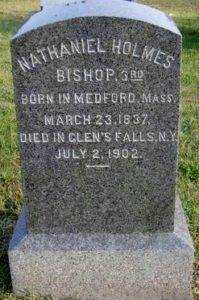

Through the writings of Nathaniel Holmes Bishop, he inspired others in the future to also set their sights on crossing continents on foot. He established a legacy of adventure and generosity that has lasted through the ages.
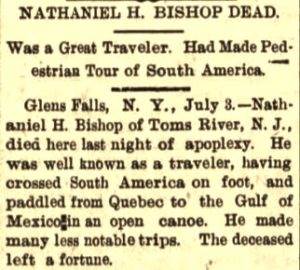



Read the entire transcontinental series:
- 1855 Walk Across South America
- Dakota Bob – Transcontinental Walker
- Zoe Gayton – Woman Transcontinental Walker
- The Wheelbarrow Man – Lyman Potter
- Edward Payson Weston’s 1909 Walk Across America
Sources:
- Nathaniel H. Bishop, A Thousand Miles’ Walk Across South America
- Nick Harris, A Man in a Hurry: The Extraordinary Life & Times of Edward Payson Weston
- Wicked Local Medford
- Andy Milroy, “Long Distance Record Book”)
- ibiblio.org
- Findagrave.com
- http://www.usacrossers.com/
- Asbury Park Press (New Jersey), May 7, 1997
- The Daily Journal (Montpelier, Vermont), Jul 3, 1902
- Ocean County Library
